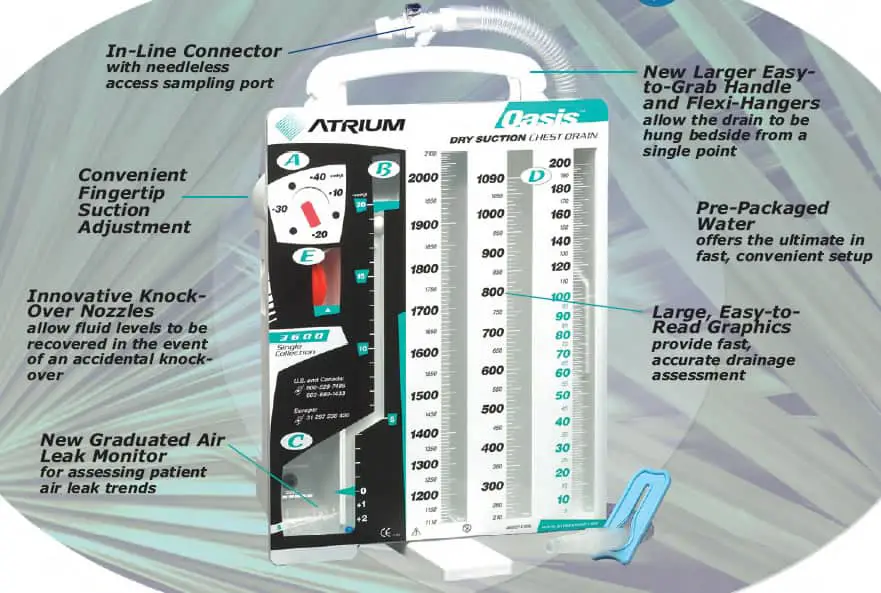As a nurse, encountering a patient with a chest tube can be daunting. But fear not! With the right knowledge and tools, you can confidently manage chest tubes and provide excellent patient care.
This guide will walk you through the essentials of chest tube management, focusing on the crucial DOPE mnemonic.
What is a Chest Tube?
Before we discuss the mnemonic, let’s briefly review what a chest tube is and why it’s used.
A chest tube is a hollow, flexible tube inserted into the pleural space to drain air, blood, or fluid, restoring normal lung function. Common reasons for chest tube placement include:
- Post-surgical drainage (e.g., after thoracic surgery)
- Pneumothorax (air in the pleural space)
- Hemothorax (blood in the pleural space)
- Pleural effusion or empyema
The DOPE Mnemonic: Your Chest Tube Troubleshooting Guide
When managing a chest tube, the DOPE mnemonic is your go-to tool for quick problem-solving. Let’s break it down:
D – Dislodgement
Signs:
- Sudden air leak
- Crepitus (subcutaneous emphysema)
- Tube visible outside the chest wall
Action:
- Apply an occlusive dressing immediately
- Notify the physician STAT
- Prepare for possible chest tube reinsertion
O – Obstruction
Signs:
- Sudden cessation of drainage or bubbling
- Absent tidaling (fluctuation in fluid level)
- Patient distress or dyspnea
Action:
- Check for kinks in the tubing
- Assess for visible clots
- If allowed, gently squeeze the tube to move clots
- Notify the physician if the problem persists
P – Pneumothorax
Signs:
- Sudden increase in air leak
- Respiratory distress
- Decreased breath sounds on affected side
- Hypotension and tachycardia (if tension pneumothorax develops)
Action:
- Assess the patient’s respiratory status
- Check all connections for leaks
- Notify the physician immediately
- Prepare for possible chest X-ray or additional intervention
E – Equipment Failure
Signs:
- Visible cracks or leaks in the drainage system
- Loss of water seal
- Inability to maintain prescribed suction
Action:
- Check all connections and tighten them if necessary
- Ensure proper water levels in the water seal chamber
- Replace the drainage system if it is defective
- Document the equipment failure and your interventions
Essential Chest Tube Management Tips
Beyond the DOPE mnemonic, here are some key points to remember:
- Assess regularly: Perform thorough respiratory assessments at prescribed intervals.
- Monitor drainage: Note the amount, color, and consistency of drainage. Report sudden changes.
- Maintain patency: Ensure the tubing is free of kinks and dependent loops.
- Encourage deep breathing: Help your patient with deep breathing and coughing exercises to promote lung expansion.
- Watch for air leaks: Bubbling in the water seal chamber should coincide with exhalation or coughing.
- Keep it secure: Ensure all connections are tight and the insertion site is well-taped.
- Never clamp during transport: Chest tubes should remain unclamped during patient transport unless specifically ordered by a physician.
Conclusion
Managing a patient with a chest tube doesn’t have to be scary. By mastering the DOPE mnemonic and following best practices, you’ll be well-equipped to provide excellent care. Remember, your keen observation skills and quick action can make all the difference in a patient’s recovery.
Stay confident, stay observant, and when in doubt, don’t hesitate to seek help from your colleagues or the attending physician. You’ve got this!
References
Hernandez, M. C., El Khatib, M., Prokop, L., Zielinski, M. D., & Aho, J. M. (2018). Complications in tube thoracostomy: Systematic review and meta-analysis. Journal of Trauma and Acute Care Surgery, 85(2), 410-416.
Kesieme, E. B., Dongo, A., Ezemba, N., Irekpita, E., Jebbin, N., & Kesieme, C. (2012). Tube thoracostomy: Complications and its management. Pulmonary Medicine, 2012, 256878.
